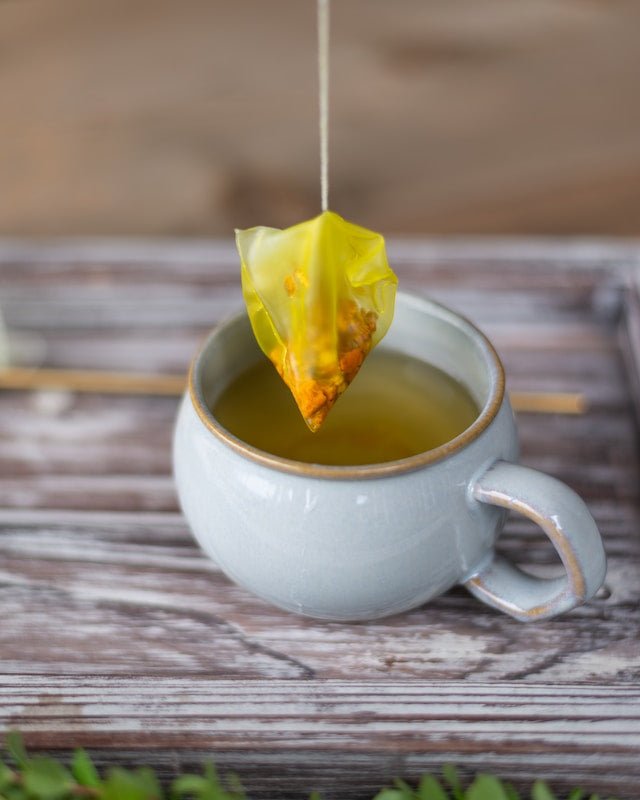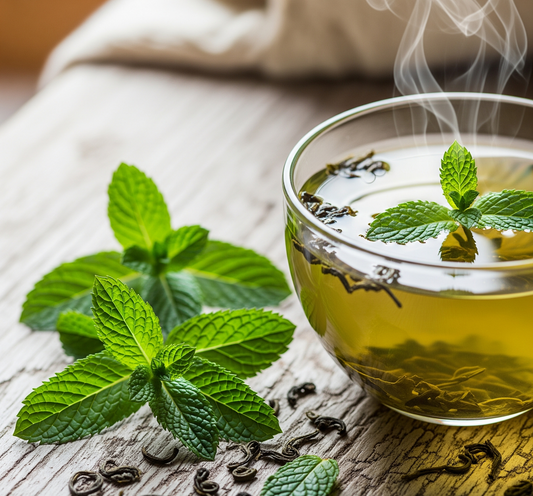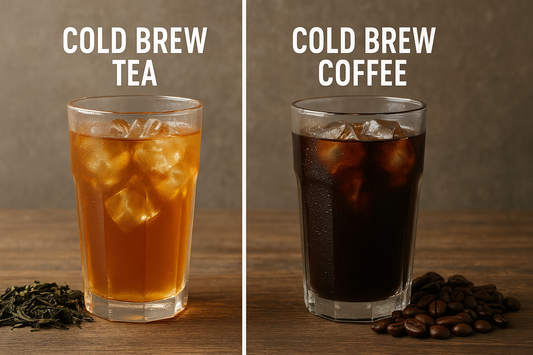Since the 1950s, when tea bags gained popularity in the mainstream market, a variety of tea bag design and materials are available on the market. Read about the history of tea bags.
With so much variety available, it can be difficult to choose the right kind of tea bags. In this blog, we’ll give you some tips on how to choose the right kinds of tea bags to fulfill your tea needs.
Why do tea bags come a variety of designs and materials?
The flavor, quality and storage of your tea can be significantly impacted by the tea bag design and material.
While many tea enthusiasts prefer the richer infusions of loose-leaf tea brewed in tea pots, infusers or strainers, many tea drinkers opt for the convenience of tea bags, which can be easier to store, brew and clean up afterwards.

Traditional flat tea bags mainly made of filter paper are widely used today. However, because of the size of these tea bags, they don’t allow whole leave teas to fully unfurl and release their flavors.
Most flat, paper tea bags are packed with low-grade broken or Fannings tea leaves that are left-over from the production process. These teas are weak, bitter and astringent to taste.
Many tea lovers consider pyramid tea bags, with their wider shape and packed with whole leaves that aren’t crushed while brewing, a step above standard flat tea bags.
However, many pyramid tea bags available, and especially those that appear silken, are made of nylon and other plastic blends. Similarly, many standard flat tea bags are also treated with polypropylene, a thermoplastic substance, used to ensure that the tea bag doesn’t disintegrate in water.
Not only are these tea bags non-biodegradable, they also release millions of microplastics into a single cup of tea. Therefore, many tea drinkers are switching to compostable and plastic-free tea bag options.
So How to Choose Your Ideal Type of Tea Bag?
Traditional Tea Bags (Flat Tea Bags):
Usually square and rectangular, and sometimes round in shape, flat tea bags are most commonly used. They are typically made of bleached filter paper, and treated with fine plastic substances to keep the bag intact while brewing.
Why choose traditional tea bags?
Traditional tea bags are typically packed with low-grade, cost-effective broken tea leaves and Fannings, which is tea-leaf dust left-over from the tea production and grading process. They are cheaper than most teas on the market, and are easily available in a variety of blends and flavors. Similarly, they are easy to store and use, since the material is bleached and treated with plastic.
Why not to choose flat tea bags?
Flat tea bags contain low-grade broken leaves and Fannings, and the taste of the tea can be weak and bitter. Additionally, as they are bleached and treated with plastic, the tea bags can not only be harmful for health, but they can also be bad for the environment.

Pyramid Tea Bags:
With a wide base and a narrow top, pyramid tea bags provide space for tea leaves to fully expand while steeping, allowing for a better infusion. They are usually made of nylon, or biodegradable materials such as cornstarch-based fabric, which is heat resistance and allows for better infusions of tea.
Why choose Pyramid Tea Bags:
Pyramid tea bags are a great choice for tea drinkers looking for richer, tastier and more aromatic brews while also seeking the brewing convenience of tea bags. Pyramid tea bags not only allow whole leaves to unfurl properly, they also contain higher quality leaves and herbal blends.
Why not to choose Pyramid Tea Bags:
As many pyramid tea bags are made of nylon, they are not compostable and also release a lot of microplastics into your drink and in the environment. Pyramid tea bags are also sold at higher prices than traditional tea bags and might be too expensive for regular tea drinkers.

Sachet:
Sachets are similar to pyramid tea bags but are often larger. They are often used to package higher-quality teas, such as whole-leaf teas and larger herbal blends. Sachets are commonly made from silk or nylon, providing ample room for the tea leaves to expand while steeping.
Why choose Sachet Teas?
Sachets, like pyramid tea bags, contain higher quality, whole leaf teas. They make for better brews than flat bags and even Pyramid tea bags, as they are larger and allow more space for the tea leaves to unfurl while steeping.
Drawbacks of Sachets:
Like with pyramid tea bags and flat tea bags, sachets are also made of nylon and other plastic blends. According to beyondplastics.org, these types of tea bags can release up to 11 billion microplastics and 3 billion nanoplastics into a single cup of hot tea, resulting in serious potential health impacts.
Double Chamber Tea Bags:
Double chamber tea bags have two compartments, allowing for a combination of tea leaves and complementary herbs or spices. The bags are made from filter paper or a similar material, with two separate compartments.
Why Choose Chamber Tea Bags?
Double chamber tea bags have been a luxury product in the tea world for many years and have recently become more widely available. Owing to its design, the double chamber tea bag allows for better water flow and more delicious infusions of tea. Higher volume of tea leaves and blends can also be packed into double chamber tea bags.
Drawbacks of Chamber Tea Bags:
If you prefer classic teas over herbal blends, chamber tea bags might be harder to find. They are also solder at higher prices than traditional single-envelop tea bags.
Environmentally Friendly and Compostable Tea Bags:

Drawstring Tea Bags:
Drawstring tea bags are regular flat bags with a drawstring attached, allowing the bag to be tightly closed after filling it with tea. They are commonly made from filter paper or a blend of paper and mesh, and the drawstring can be made from cotton or other materials.
Silicon Tea Bags:
Silicon tea bags are reusable, and they come in various shapes, including spherical or cylindrical forms. These bags are made from food-grade silicone, which is durable, easy to clean, and environmentally friendly.
Compostable and Biodegradable Tea Bags:
Compostable or biodegradable tea bags can come in flat, pyramid, sachet or double chamber designs. However, materials used are always plant-based, such as polylactic acid fabric derived from cornstarch, cotton, or other biodegradable fibers, making them environmentally friendly.

Frequently Asked Questions:
Are there different types of tea bags?
Yes, tea bags come in a variety of designs and materials. Traditional flat tea bags, pyramid tea bags, sachets, double chamber bags, drawstring tea bags and silicon tea bags.
What type of tea is typically in tea bags?
Tea bags are typically considered to contain lower grades of tea. Many tea bags contain broken tea leaves or Fannings (tea dust), which are considered to be leftovers from the whole leaf tea production process. However, with designs like pyramid tea bags, sachets, and double chamber and drawstring tea bags, whole leaf teas can also be packed into tea bags and brewed to achieve flavors similar to loose-leaf teas.
What are some common types of tea bags?
The most common type of tea bags available on the market are flat, single envelop filter paper tea bags. These tea bags tend to contain lower grades of tea. Pyramid tea bags are now gaining popularity, packed with higher grades of tea and better brews. However, many Pyramid tea bags are made of nylon or other plastic blends, severely impacting the environment and having potential health impacts.
Can Tea Bags Get Moldy?
Yes, tea bags can grow mold. While tea doesn’t expire, old tea that is stored improperly can lose its flavor, while also being susceptible to mold, especially if the tea is packaged in organic material. Therefore, it is best to store your tea properly and drink your teas regularly!
What are Reusable Tea Bags?
Reusable tea bags are drawstring tea bags made of cotton or other plant-based materials. Reusable tea bags are environmentally friendly, contain less chemical processing than other types of tea bags, and can be rinsed and packed with any loose-leaf tea of your choosing. Reusable tea bags can be used if you don’t have tea brewing tools such as infusers, strainers or tea pots.
Are tea bags full of chemicals?
Yes, many commercially made tea bags are bleached and treated with plastic substances, in order to preserve the teas packed inside them as well as the shape of the tea bag itself. Heavy metals and microplastics are commonly found in tea bags. However, tea bags made of plant-based and organic materials that are compostable or biodegradable have low to zero amounts of harmful chemicals.
What kinds of tea bags are plastic free?
Tea bags made of bio-degradable materials, such as PLA, filer paper, cornstarch derivatives, cotton or silk, or silicon are plastic free. A variety of organic, compostable and biodegradable tea bags are available on the market.
For those seeking the convenience of tea bags that match the flavor and fragrance of loose-leaf tea, Nepal Tea Collective is now launching our very own plastic-free, biodegradable, organic pyramid whole leaf tea bags! Stay tuned with us to get your tea bags in your favorite flavors.




